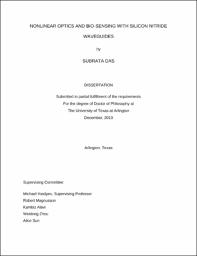
ATTENTION: The works hosted here are being migrated to a new repository that will consolidate resources, improve discoverability, and better show UTA's research impact on the global community. We will update authors as the migration progresses. Please see MavMatrix for more information.
Show simple item record
| dc.contributor.advisor | Vasilyev, Michael | |
| dc.creator | Das, Subrata | |
| dc.date.accessioned | 2021-01-12T17:11:17Z | |
| dc.date.available | 2021-01-12T17:11:17Z | |
| dc.date.created | 2019-12 | |
| dc.date.issued | 2019-12-06 | |
| dc.date.submitted | December 2019 | |
| dc.identifier.uri | http://hdl.handle.net/10106/29660 | |
| dc.description.abstract | Silicon Nitride (SiN) is a CMOS compatible optical material that can be used for both linear and nonlinear optics applications. SiN has high refractive index (1.99-2.0) and low two photon absorption (TPA) coefficient. As a result, SiN can be used as a core material to guide and bend light, and the development of compact on-chip SiN optical devices exploiting both linear and nonlinear optical phenomena is very much feasible.
In this thesis work, two independent research projects are presented. The first work presents the design of a hybrid SiN/Polymer slot waveguide for second-harmonic generation (SHG) of a 1550-nm wave at 775 nm. This is a simulation-based work where the waveguide dimensions are numerically optimized to fulfill the conditions required for SHG in a bended structure, i.e. microring. This work presents an optimum slot waveguide design with very high effective nonlinearity, with a critical slot dimension of 200 nm that is very much attainable in a class 100 cleanroom facility like Shimadzu Institute- Nanotechnology Research Center, University of Texas at Arlington and shows prospect of developing waveguide and micro-resonator based nonlinear photonic integrated circuits.
In the second project, a microring resonator has been designed, fabricated and characterized for biosensing applications. The fabrication steps are discussed thoroughly so that it can be replicated in future research endeavors. This fabricated optical biosensor has been designed to work in aqueous environment, so that the presence of particular biomaterial, in this case Neuropeptide Y (NPY), can be easily detected and quantified according to sample concentration at µg/ml level. The experimental investigations confirm that the detection limit of this microring resonator in a single assay system is 1 µg/ml with a sensitivity of 0.1 nm/(µg/ml). This sensitivity can be amplified by a factor of 3 by using sandwiched assay system, and NPY concentration at 0.25 µg/ml level was successfully detected. | |
| dc.format.mimetype | application/pdf | |
| dc.language.iso | en_US | |
| dc.subject | Nonlinear optics | |
| dc.subject | Second harmonic generation | |
| dc.subject | Silicon nitride waveguide | |
| dc.subject | Slot waveguide | |
| dc.subject | Neuropeptide Y | |
| dc.subject | Refractive index sensor | |
| dc.subject | Micro-ring resonator | |
| dc.title | Nonlinear Optics and Bio-sensing with Silicon Nitride Waveguides | |
| dc.type | Thesis | |
| dc.degree.department | Electrical Engineering | |
| dc.degree.name | Doctor of Philosophy in Electrical Engineering | |
| dc.date.updated | 2021-01-12T17:11:18Z | |
| thesis.degree.department | Electrical Engineering | |
| thesis.degree.grantor | The University of Texas at Arlington | |
| thesis.degree.level | Doctoral | |
| thesis.degree.name | Doctor of Philosophy in Electrical Engineering | |
| dc.type.material | text | |
| dc.creator.orcid | 0000-0003-4639-1919 | |
Files in this item
- Name:
- DAS-DISSERTATION-2019.pdf
- Size:
- 2.287Mb
- Format:
- PDF
This item appears in the following Collection(s)
Show simple item record


